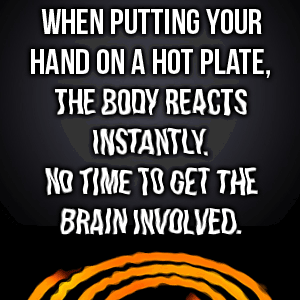
It’s happened to all of us – reaching for a plate only to make the unfortunate discovery that it’s scalding hot and in danger of giving your hand a nasty sizzle, so, quick as a flash, you drop it.
This might seem like a rather uninteresting sequence of events, but in fact it’s a rare exception to the way your body normally functions – an exception that is probably one of the reasons why humans are still around.
The human nervous system can be divided into two parts: the central nervous system (CNS) and the peripheral nervous system (PNS). The central nervous system is made up of the spinal cord and the brain, while the peripheral nervous system is everything else, right down to the pain sensors in your big toe. These two systems work together to basically control everything you do.
Read: Changes in the brain slow down reactions
As you know, the brain is where all the decisions happen. This includes both the conscious decisions you make, like moving your hand to pick up your cell phone, and the unconscious ones, like increasing your heart rate when you’re exercising. The peripheral nervous system is responsible for carrying out these actions – these are completed through motor neurons, which move your hand or stimulate the muscles of the heart, and sensory neurons which tell you that you’ve done it.
So, what’s different about the hot plate scenario mentioned above? Put simply, the reaction to sensing the hot plate doesn’t go through the brain. As it turns out, the most complex and sophisticated "thing" known to mankind isn’t up to the task of dealing with a simple hot plate. Why? Because it isn’t quick enough, according to research published in Brain.
While you might think that your mind works pretty quickly, and it does, because of its incredible complexity (there are as many as 100 trillion connections in the human brain), some simple tasks can take longer than they should. In the case of a potentially hazardous scenario, every nanosecond counts, and that’s why the reflex arc, as its known, bypasses the brain.
Instead, the decision is made in the spinal cord. Normally, nerves of the PNS feed into the relative safety of the spinal cord where they travel up to the brain, and once the brain has decided upon a response, different nerves carry that response back down the spinal cord and out to the relevant area. In the case of the reflex arc, however, the nerve goes into the spinal cord and the stimulus is of such magnitude that small neurons called interneurons realise that action needs to be taken immediately and feed the response straight back into the motor neurons of the PNS and the necessary action is carried out.
Read: Second-hand smoke impairs cough reflex
Your brain will still of course realise what has happened, but the actual sensation of heat and the realisation of what’s happened will often occur around the same time, or just after the reflex arc has caused your hand to release the plate. The speed of the reflex is incredible, with the reaction to touch stimuli occurring in just 15 milliseconds, claims a study published in Multidisciplinary Respiratory Medicine.
Other examples of a reflex arc include the knee jerk response, your response to touching something sharp, and the multitude of tiny actions that help you to maintain balance and posture.
Read more:
Athlete's incredible reflexes
After ovulating, women spot snakes faster
Acupuncture can help you overcome the gag reflex




 Publications
Publications
 Partners
Partners














